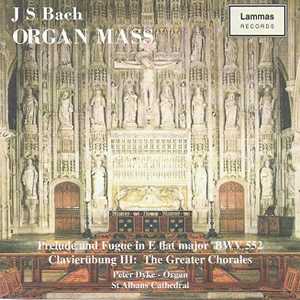JS Bach Organ Mass

Clavierübung III: The Greater Chorales
Präludium BWV 552
Kyrie, Gott Vater in Ewigkeit BWV 669
Christe, aller Welt Trost BWV 670
Kyrie, Gott heiliger Geist BWV 671
Allein Gott in der Höh sei Ehr BWV 676
Dies sind die heilgen zehn Gebot BWV 678
Vater unser im Himmelreich BWV 682
Christ, unser Herr, zum Jordan kam BWV 684
Aus tiefer Not schrei ich zu dir BWV 686
Jesus Christus, unser Heiland BWV 688
Fuga - BWV 552
Total playing time 70m
JS Bach Organ Mass
JS Bach Organ Mass
The twenty-seven works of the Clavierübung III were the first organ music to be published by Bach and their appearance in 1739 allowed a wider audience to appreciate some of his greatest contrapuntal artistry. The bulk of the collection comprises twenty-one pieces based on Lutheran chorale melodies. In most cases each chorale is set twice, with one large scale work for manuals only (the exception is Allein Gott, which receives two small scale settings). The chorales chosen are among those likely to have been used most frequently because of their position in the Lutheran Mass (Kyrie, Gloria) or their relevance to the teaching of a particular aspect of faith (the Ten Commandments, Baptism, the Lord"s Prayer, the Communion).
The twenty-one chorale settings are followed by four duets and the whole collection is framed by the great E flat major Prelude and Fugue. The present recording includes this Prelude and Fugue and each of the ten larger scale Chorale preludes, thus creating a more concise and flowing programme for the listener than would the complete Clavierübung III.
To refer to the resulting collection of pieces as an "Organ Mass" is perhaps presumptuous, as it is unlikely that Bach would have envisaged their performance collectively in any one service, and the hymns chosen are far from being confined to the Ordinary of the Mass. However, Bach"s intention seems to have been to provide exemplary marerial not only for the teaching of keyboard technique (as implied by the title) but also to give some impression of the depth of his musical and religious experience (as is shown by the sympathetic and vivid ways in which he illustrates the theological subjects upon which the hymns are based). By acknowledging the power of music to convey and teach religious ideas, Bach is closely following the philosophy of Luther himself and making his own contribution to the mission of the Lutheran Church.
The final work of Clavierübung III (sometimes known as the "St Anne" because of the subject's resemblance to the hymn tune of that name) is possibly Bach"s greatest fugue. Trinitarian symbolism abounds, most obviously in the fact that there are three separate fugues (representing the three persons of the Trinity) bound together into one by the use of the first subject in all three, and also in the three flats of the key signature, the number of bars in each section, the number of appearances of each fugue subject (multiples of three), and so on. Bach even makes a theological analogy by providing so much to be discovered by anyone who cares to search! This awe-inspiring and majestic work provides an appropriate conclusion to the monumental collection of music that forms Clavierübung III.
Peter Dyke
Peter was born in Harpenden, Hertfordshire, in 1965. In 1983 he took up an organ scholarship to the newly-founded Robinson College, Cambridge, and obtained his fellowship of the Royal College of Organists in 1987.
Since graduating from the university he has enjoyed a busy and successful freelance career. He has worked with a wide range of choirs as accompanist and conductor for frequent concerts and recordings. After five years as organist of St Helen"s, Wheathampstead, he was Assistant Organist at St Woolos Cathedral, Newport, from 1992 until 1995, when he became Organ Scholar at St Albans Cathedral. He is also much in demand as an instrumental teacher and while in Newport founded the Gwent Organists" Training Scheme in association with the Royal School of Church Music.
Peter regularly gives concerts as a soloist both in the British Isles and abroad; recent appearances have included recitals in Norway, Germany, France and the Czech Republic. In July 1993 he was awarded the Joint Second Prize in the Interpretation Competition at the St Albans International Organ Festival.
DirectorName
Put director details here.
Put director details here.
OrganistName
Put organist details here.
Put organist details here.
Put organist details here.
Produced by John Dyke
Recorded and edited by Lance Andrews
Cover photograph by Peter Smith (of Newbery Smith Photography - Pitkin Guides Ltd)
Peter Dyke would like to thank Lance Andrews, Edward Breen, John Dyke, Christopher Gray, Ben Harris, Jane Kelman-McConnachie, Dorothee Nauth, Barry Rose, David Sanger and David Whitehead for their help with this recording.